Alex
Moderator
What Is Plaster?
Plaster is a part of such a building, which is used for the protective or decorative coating of parts like walls and ceilings, which facilitates molding and decorating the walls.Plaster is known to almost everyone, which is coated to decorate the house, which is an innovative mixture of gypsum, cement, sand, and water. Used for various applications.
Plastic materials are used to construct houses and other constructions to cover rough walls, which is called plaster.
All exterior surfaces of masonry and especially joints in brick masonry are easily finished with the help of plaster.
Object of Plastering
- Defective quality can be hidden by plastering.
- The major advantage of plastering on exterior walls is that the surface resistance to rainwater and other atmospheric influences can be improved.
- Plastering is used to form smooth surfaces. So that dust and dirt cleaning can be done easily.
- The surfaces of the walls will work to protect against vermit.
- Plaster can be used to get a decorating and smooth surface.
- It increases the required durability of the surface.
- Plaster is applied to increase the quality of the wall and to strengthen and cover the joints formed in the masonry work.
Type of Plaster
Its type depending on the material in the plaster.1. Lime Plaster
This type of plaster uses lime. Hydraulic lime contains particles that are slowly slaking when exposed to atmospheric moisture. The slacking process lasts for 6 to 8 months.If such plaster remains unslaked, particles slowly form during the slaking process. This causes damage to the plaster surface.
A mixture of sand and lime is used in lime mortar. The ratio is 1: 3, in which 3 parts are mixed with sand and 1 part with lime. This combination is used as an undercoat and finish coat.
2. Cement Plaster
Cement plaster is usually a uniform mixture of Portland cement, fine aggregates, and water. OPC 43 and OPC 53-grade cement mixed with sand is also known as cement-sand plaster. PPC cement is preferred over OPC-grade cement for plastering.A single coat of plaster in the interior walls is enough to finish. If the thickness of the plaster is more than 15 mm or the exterior needs finishing, two coats of plaster are required.
If the surface is very uneven, three coats of plaster should also be applied where the first coat is scratched without finishing. Then the next second base coat is applied. For the exterior wall, usually, two coats of plaster are required. The thickness of plaster is kept from 20 to 25 mm.
The thickness of the cement plaster depends on the composition of the construction and its surface.
The minimum plaster thickness for concrete wall surfaces should be 10 to 12 mm.
Plaster thickness 12 mm or 18 mm is kept in the place of unevenness on brick masonry surfaces.
A thickness of 20 mm is kept in the place of any surface, which is highly uneven.
3. Gypsum Plaster
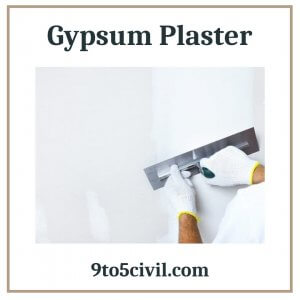
When the dry POP powder is mixed with water, it begins to harden. This mixture is applied to a brick, block, or concrete surface called gypsum plaster.
A 6 mm coat of gypsum plaster is usually applied to the surface of the cement plaster before painting. This process is done in two stages.
This process is gradually replacing single coat gypsum plaster. Readymade POP powder for gypsum plaster can be applied directly to the wall by mixing water.
Gypsum plaster can be applied to solid, any brick or hollow blocks, AAC blocks and plasterboards, etc.
Gypsum plaster has good insulation properties. It also serves as a good fire retardant. Gypsum saves a lot of time during construction. These properties have attracted the attention of builders and contractors to choose gypsum plaster over traditional cement plaster.
Type of Plaster Finishes
- Smooth Coat Finish
- Sand Faced Finish
- Rough Cast Plaster Finish
- Pebble Dash Plaster Finish
- Scrapped Plaster Finish
- Depeter Plaster Finish
- Textured Plaster Finish
- Special Material Used in Plastering for Finishing Coat
- Acoustic Plaster
- Asbestos Marble Plaster
- Barium Plaster
- Granite Silicone Plaster
- Keene’s Cement Plaster
- Scagliola Plaster
- Martin’s Cement Plaster
- Sirapite plaster
1. Smooth Coat Finish
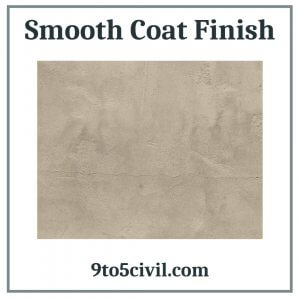
To finish a smooth cast, mortar should be mixed in a ratio of 1: 3 [cement: sand]. Fine sand should be used to make mortar. To spread the mortar, a steel float or a wooden float should be used. Therefore, a smooth and flat surface can be obtained.
2. Sand Faced Finish
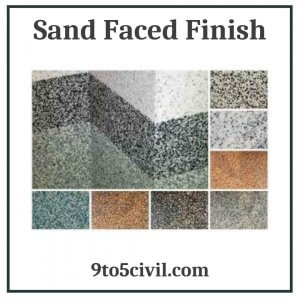
This type of finish is plastered in two coats. For the first coat, mortar is made in a 1: 4 ratio of cement and sand. The first coat is made in a layer 12 mm thick.
The first coat is not finished. It is made into a rough surface in a zigzag line. Water is sprayed for 7 days.
The second coat is finished in an 8 mm thick layer by mixing cement and sand in a 1: 1 ratio. The surface is designed using a sponge. The finish can also be obtained by using a wooden float.
3. Rough Cast Plaster Finish
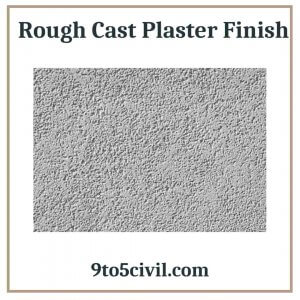
Mortar mix for roughcast finish is cement and sand, and course aggregate. The ratio for this mortar is about 1: 1.5: 3. The overall size of coarse used in mortar varies from 3 mm to 12 mm.
A large amount of mortar is finished by trowel. Leveling and roughened using a wooden float. This type of finish is usually used for external rendering.
4. Pebble Dash Plaster Finish
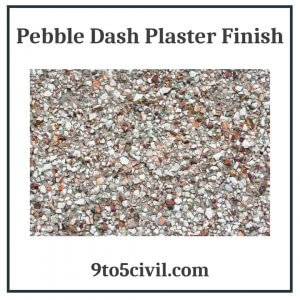
For pebble dash finishing, a 12 mm thick mortar layer is applied. For this type of finish, the ratio of mortar is kept at 1: 3. The size of the clean pebble is kept from 10 to 15 mm.
The gravel is pressed into the mortar using a wooden float. Looks amazing when the mortar dries.
5. Scrapped Plaster Finish
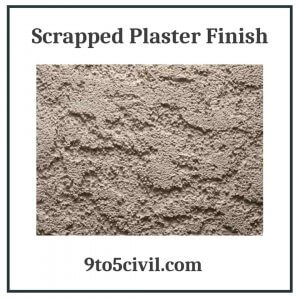
For the scraped finish, a layer of mortar of 6 to 12 mm thickness is applied. After laying, the mortar is allowed to dry for a while. Then in this finish, the layer of plaster is scraped at short intervals to a depth of 3 mm using a steel blade or plate. Cracks can be hidden from such scraped surfaces.
6. Depeter Plaster Finish
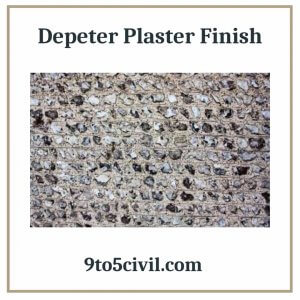
This is also the same as the pebble dash finish. But in this case, pieces of gravel or flints are used instead of gravel. Different beautiful patterns can be created using flints of different colors.
7. Textured Plaster Finish
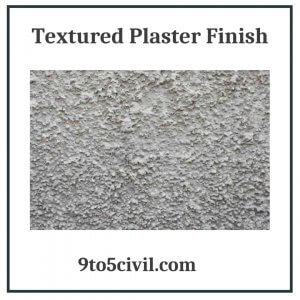
The textured finish is obtained by the process of stucco plastering. In which different textures or shapes are given on the final coat using different tools in stucco plastering.
8. Special Material Used in Plastering for Finishing Coat
Special materials are mixed into the mortar to provide some special requirements for surfaces. These include special requirements such as durability, better appearance, fireproofing, heat insulation, etc.8.1 Acoustic Plaster
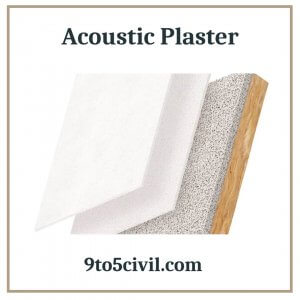
Gypsum is added to cement mortar for acoustics plaster. This type of finish is done in two coats. Each of these coats has a thickness of 6 mm. When undergoing a chemical reaction between gypsum and mortar. Then bubbles are formed in the plaster, which has the property of absorbing sound. Due to such properties, it is called acoustics plaster. Acoustic plastering materials are used in cinema halls, auditoriums, etc.
8.2. Asbestos Marble Plaster
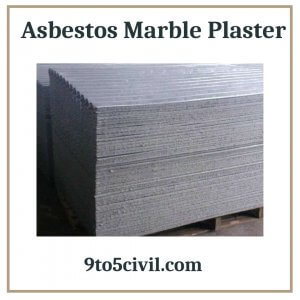
Asbestos marble plaster is used by mixing marble in a mortar to finish the surface of the plaster. It can be given effect by adding asbestos, powdered marble in mortar.
8.3. Barium Plaster
Barium cement is obtained by adding barium sulfate to the mortar mixture for plaster. This type of plaster is used for X-ray room finishing. This type of plaster has the property of absorbing radiation from X-ray machines without affecting people.8.4. Granite Silicone Plaster
Granite and silicone are mixed in mortar for this type of plaster.This type of plaster has high elastic properties. This plaster reduces the chances of cracking due to the action of the weather.

